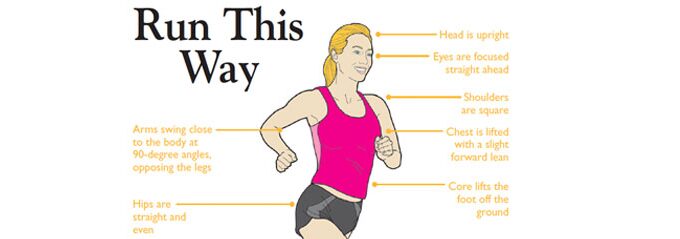Lace up your tennis shoes and go!! Just kidding! Ok, let’s back up a bit.
First, depending on what kind of shape you are in and your age you may want get a physical from your doctor to get the all clear to take that first step.
Next, Clothes. Yes, you can technically wear a cotton t-shirt, pair of shorts (not jean shorts!) and your yard tennis shoes but if you don’t want to be a sweaty, hot mess five minutes into it, invest in a dry wick/poly blend shirt and running shorts or pants. When the temperatures dip dress in layers so you can easily adjust. Keep in mind you will warm up at least 10 degrees within the first mile or two into your run so it is important not to over dress.
Shoes: You must get some quality running shoes. I highly suggest going to a specialty, local running store such as Varsity Sports or Fleet Feet so they can check your feet and see how you walk so they can properly fit you.
Jenni Peters owner of Varsity Sports with 30 + years of running experience says: “The only absolutely necessary piece of equipment is a good shoe specifically designed for running. There is nothing wrong with the less expensive, less technical shoes from the major brands but if someone is involved in serious training that one single thing ‘a good pair of shoes’ is critical. Plus it is key to match a shoe type to your own biomechanics. That’s where the professionals at your local running store play a part.”

Buddy up: Don’t forget the sunblock and if you can recruit a neighbor or friend to join you. It’s easier to walk out that door if you have someone waiting on you. Add on an inexpensive watch that has stop/start capabilities so you can track your time, distance and pace such as the Garmin Forerunner 10 GPS watch.

Safety First: Run against traffic. If you run at night, make yourself visible by wearing light-colored, reflective clothing. Carry identification. Take a basic self-defense class if you are going to be running solo. Always trust your intuition. If you’re unsure about a person or a place, avoid it.
Music: This is optional but if you do choose to run with music please keep it low so you can be aware of cars, cyclists and people around you. If you are into trail running I wouldn’t advise running with music since most races do not allow them and you need to hear the people around you.
Warm up: Jog for 5-10 minutes to warm up muscles. It is not recommended to stretch cold muscles. Save your main stretching segment for after your run. (See link below for Stretching)
Running form: Head up, Eyes forward on the horizon, Shoulders relaxed, Arms low and loose, Elbows bent about 90 degrees, Don’t clinch your fists keep your fingers light like you are holding a potato chip, Run tall, chest high like a balloon is lifting you up, let your legs do the work they should feel quick with your stride short with feet landing underneath you and your feet landing on your heel to mid-foot. Try not to twist at the hips. (I am personally bad about this) Hips should be pointed straight ahead. 
Start off slow: Ease into your run. Start slow and push mid way and into a strong finish by saving some gas for the end. You can start off with one mile or 15 minutes your choice. Next time go two miles / 30 minutes. Start a running log to track what you ate, drank, dressed, weather outside as well as how long or far you ran. Track how you felt after your run. Start off slow and only add 10% to the following week. It’s easy to get overzealous on a nice morning and tack on extra miles but doing this regularly will lead to injury which is best to avoid if at all possible. (Trust me I am coming off an injury right now from adding mileage too fast and now I am having to rebuild all over again)
Make a schedule: We all have busy schedules so take the time to plan out when is the best times to get your running in. Whether it is mornings, afternoons or evenings. What days of the week work best for you? Plan out at least a month in advance, put it in your calendar and stick to it. Need a training plan? Google it and find the best one that works for your schedule, running pattern and goals. (See link below on various training plans)
Strength train: Running injuries, especially knee and hip-related problems, are often a result of muscle weaknesses or imbalances. Core and lower body exercises are especially important for injury prevention. If you like Spin class, Yoga or Swimming add these workouts to your weekly schedule.
Don’t get discouraged: You have already taken that first step which is the most important. Now write down some goals whether it is signing up for a 5k or 10k that you have had your eye or to simply to feel better about yourself. Learn what inspires you and keeps you motivated.
It is a lot to remember and can get overwhelming but the main things are Breathe, Focus and be Patient. I have been running since 2011 and I STILL have lots to learn. I am no expert but fortunately there are endless resources out there from various running websites, Facebook groups even local running stores sometimes have running programs and weekly runs to join in. You simply have to ask.
Resource suggestions:
• Stretching: http://www.runnersworld.com/training/stretching
• Running Form: http://www.runnersworld.com/running-tips/perfect-form
• Avoiding Injury: http://m.runnersworld.com/sites/default/files/InjuryPrevention.pdf
• Nutrition: http://m.runnersworld.com/sites/default/files/NutritionGuide_0.pdf
• Gear Guide: http://m.runnersworld.com/sites/default/files/GearGuide.pdf
Examples of training plans:
• http://www.fitnessmagazine.com/workout/running/training-schedules/5k-10k-half-marathon-training-plans/
• http://www.jeffgalloway.com/training/5k.html
• http://www.halhigdon.com/training/
To find races in your area: http://www.active.com/running?
Good Luck and Enjoy the Journey!


